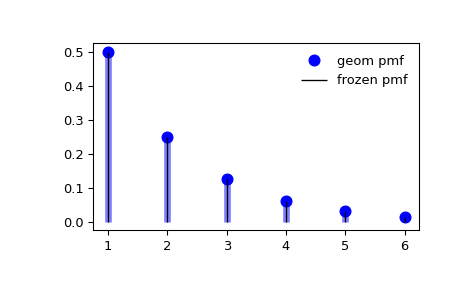scipy.stats.geom#
- scipy.stats.geom = <scipy.stats._discrete_distns.geom_gen object>[source]#
A geometric discrete random variable.
As an instance of the
rv_discreteclass,geomobject inherits from it a collection of generic methods (see below for the full list), and completes them with details specific for this particular distribution.See also
Notes
The probability mass function for
geomis:\[f(k) = (1-p)^{k-1} p\]for \(k \ge 1\), \(0 < p \leq 1\)
geomtakes \(p\) as shape parameter, where \(p\) is the probability of a single success and \(1-p\) is the probability of a single failure.The probability mass function above is defined in the “standardized” form. To shift distribution use the
locparameter. Specifically,geom.pmf(k, p, loc)is identically equivalent togeom.pmf(k - loc, p).Examples
>>> from scipy.stats import geom >>> import matplotlib.pyplot as plt >>> fig, ax = plt.subplots(1, 1)
Calculate the first four moments:
>>> p = 0.5 >>> mean, var, skew, kurt = geom.stats(p, moments='mvsk')
Display the probability mass function (
pmf):>>> x = np.arange(geom.ppf(0.01, p), ... geom.ppf(0.99, p)) >>> ax.plot(x, geom.pmf(x, p), 'bo', ms=8, label='geom pmf') >>> ax.vlines(x, 0, geom.pmf(x, p), colors='b', lw=5, alpha=0.5)
Alternatively, the distribution object can be called (as a function) to fix the shape and location. This returns a “frozen” RV object holding the given parameters fixed.
Freeze the distribution and display the frozen
pmf:>>> rv = geom(p) >>> ax.vlines(x, 0, rv.pmf(x), colors='k', linestyles='-', lw=1, ... label='frozen pmf') >>> ax.legend(loc='best', frameon=False) >>> plt.show()

Check accuracy of
cdfandppf:>>> prob = geom.cdf(x, p) >>> np.allclose(x, geom.ppf(prob, p)) True
Generate random numbers:
>>> r = geom.rvs(p, size=1000)
Methods
rvs(p, loc=0, size=1, random_state=None)
Random variates.
pmf(k, p, loc=0)
Probability mass function.
logpmf(k, p, loc=0)
Log of the probability mass function.
cdf(k, p, loc=0)
Cumulative distribution function.
logcdf(k, p, loc=0)
Log of the cumulative distribution function.
sf(k, p, loc=0)
Survival function (also defined as
1 - cdf, but sf is sometimes more accurate).logsf(k, p, loc=0)
Log of the survival function.
ppf(q, p, loc=0)
Percent point function (inverse of
cdf— percentiles).isf(q, p, loc=0)
Inverse survival function (inverse of
sf).stats(p, loc=0, moments=’mv’)
Mean(‘m’), variance(‘v’), skew(‘s’), and/or kurtosis(‘k’).
entropy(p, loc=0)
(Differential) entropy of the RV.
expect(func, args=(p,), loc=0, lb=None, ub=None, conditional=False)
Expected value of a function (of one argument) with respect to the distribution.
median(p, loc=0)
Median of the distribution.
mean(p, loc=0)
Mean of the distribution.
var(p, loc=0)
Variance of the distribution.
std(p, loc=0)
Standard deviation of the distribution.
interval(alpha, p, loc=0)
Endpoints of the range that contains fraction alpha [0, 1] of the distribution